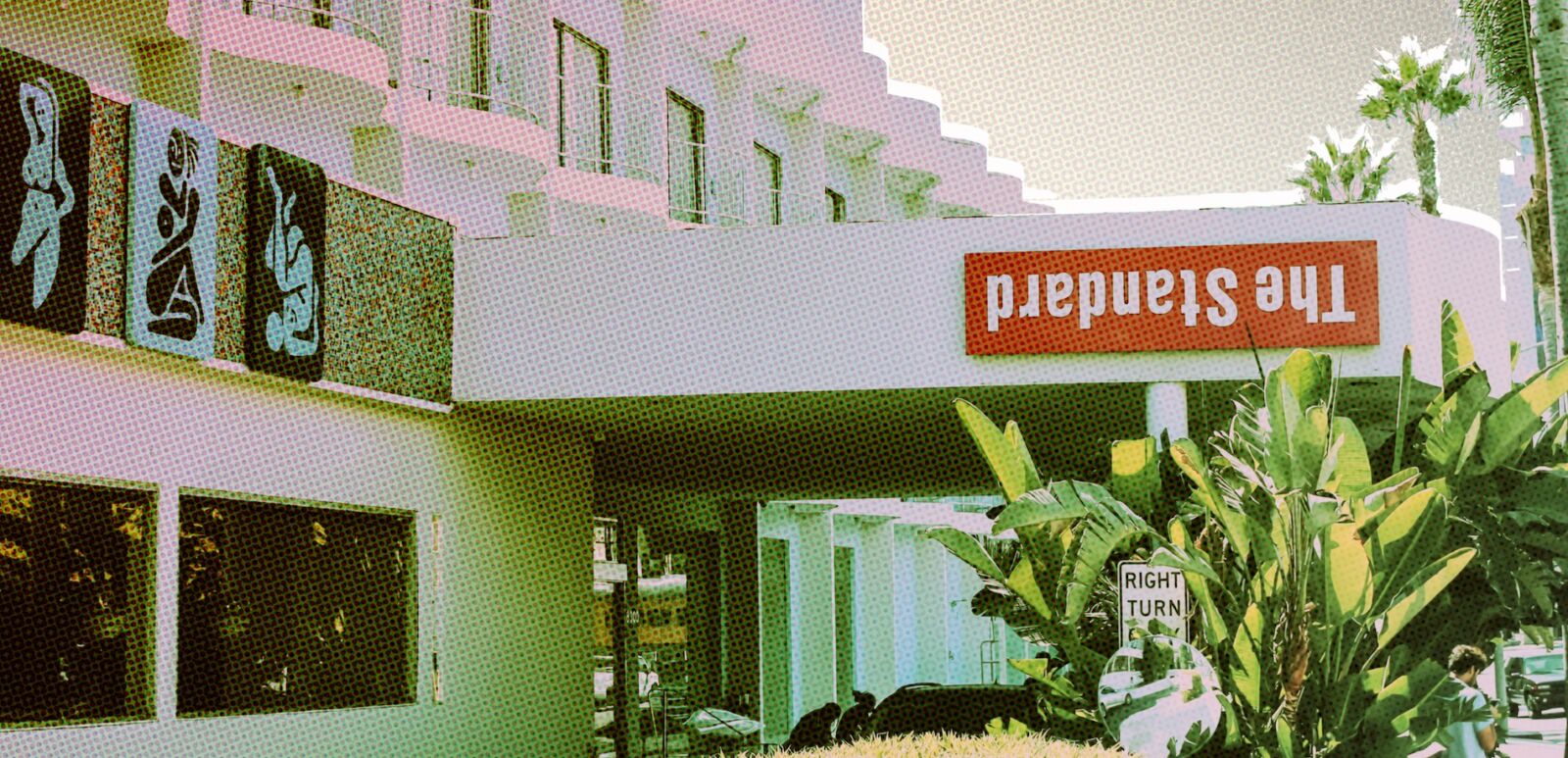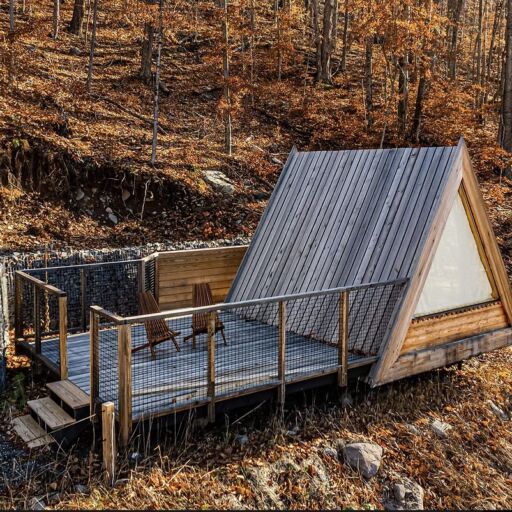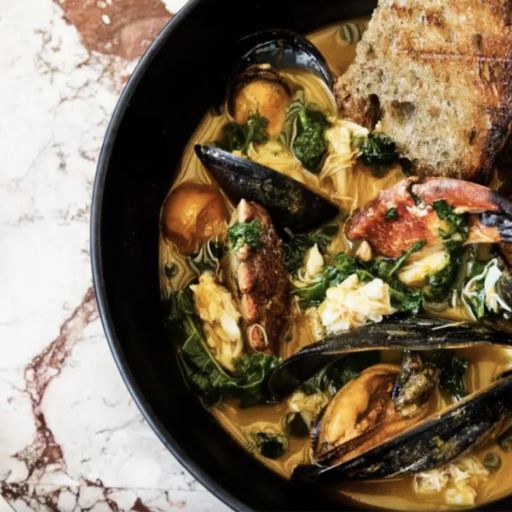If you’re of a certain age and ilk, this is hard to believe: It’s been 25 years since the buzzy opening of the original Standard hotel in Los Angeles. That 140-room, West Hollywood nightclub-as-hotel experiment helped shape expectations of the boutique hotel experience for a generation of travelers and set a tone for the brand that remains today. In the June 1999 issue of Vanity Fair, owner André Balazs described The Standard, Hollywood as “an entirely different take on the idea of an inexpensive hotel.” That new take meshed unexpected artistic endeavors (like the live models in the lobby’s glass vitrine), playful design (“blow,” “hard” and “harder” settings on the thermometers) and live music elements (DJ booth at the front desk) with mid-market price points. It was an immediate hit with locals — the hotel’s pool and Purple Lounge were prominent L.A. celeb hangouts in the early 2000s — and travelers.
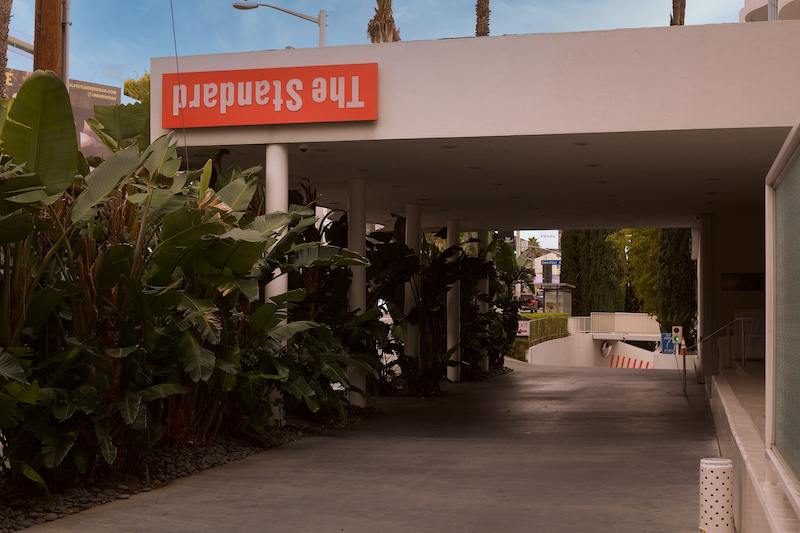
The Standard, Hollywood closed in January 2021, though the chain lives on with mostly an international footprint. Five of its eight locations are overseas and another one is set to open in Melbourne, Australia, in February 2024.
As we celebrate exceptional-yet-affordable hotels in this issue, we’d be remiss if we didn’t tip our hats to one of the first hotels that defined the category, captured the cultural zeitgeist at the turn of the century and flexed an outsized influence on the landscape of American hotels.
In this oral history, we talked to early employees, performers and guests of the original Standard to trace its path from an old retirement-home space to its heyday years of the early aughts.
The players
- Chris Black, former guest and co-host of the “How Long Gone” podcast
- Sarah Morris Brower, various positions at Rudy’s Barbershop and hotel’s diner
- Alan Dunn, food and beverage manager
- Jasmin Estrella, front desk
- Shawn Hausman, the hotel’s designer
- Lilibet Snellings Kyte, author and box model
- David Lemmond, opening assistant general manager
- Dan Mancini, DJ and operations manager
- Sebastien Meler, design staff and booker
A ‘groundbreaking idea’
The Standard, Hollywood’s designer, Shawn Hausman, started his career in the movie business as a production assistant on director Miloš Forman’s films. Later, Hausman was one of the five co-founders of an influential 1980s New York City nightclub, Area. It was noted for the use of art-in-a-nightclub setting, changing themes and collaborations with artists like Andy Warhol, Jean-Michel Basquiat and Keith Haring. After moving back to L.A., where he grew up, Hausman began designing spaces, including hotels. Hotelier André Balazs commissioned him for work at Chateau Marmont in the 1990s.
Shawn Hausman, designer of The Standard, Hollywood
I first met André briefly in New York. I believe it was when he was involved in MK Club with Eric Goode. (Editor’s note: MK Club opened in 1988, after Area closed). But the Chateau was really the first time we worked together. It was a very personal project to me. I grew up in L.A. My mom had friends who lived there, and so I had a lot of memories of the hotel. Some from being very young. When I started, André already had a couple other designers work on it. They had done model rooms, and it wasn’t really [working for] him. So I came in and did a model room.
By 1998, Balazs’ had begun work on the first Standard hotel at 8300 Sunset Blvd., on the corner of Sunset and Sweetzer. The existing structure opened in 1962 as the Thunderbird , then became the Hollywood Sunset Hotel and even later, a retirement home. Balazs turned to Hausman again when he was in need of room designs. Hausman and his team — which included design assistant Sebastien Meler — began work on model rooms in 1998.
Shawn Hausman
It was kind of this, at the time, groundbreaking idea of an affordable place. It was like a play off of all these [existing] boutique hotels, but how do you do that in an affordable way? Not necessarily a boutique hotel, but something with a conscious design aesthetic and stylish and maintain those ideas.
Sebastien Meler, hotel art director, box booker (1998-2010)
When Shawn Hausman was brought on it was basically three of us in one of the model rooms working. It was just us, and there were overnight security guards, too.
Shawn Hausman
The plan was that there were definitely going to be more Standards and it was going to be, I guess you’d call it a brand. We didn’t really use those terms so much then but when we started, the idea was that we could take this bed design and this carpet and it would work in another city. You could duplicate some of the things that we’re developing, although I didn’t design specifically in a way that was like, how are these gonna work in any property? The design was a response to the location and to the area.
“The design was a response to the location and to the area.”
— Shawn Hausman
Sebastien Meler
It was bare when we first started. It was this bare, old retirement home.
David Lemmond, opening assistant general manager
The building was old. It was not glamorous by any stretch.
Shawn Hausman
Club owners were turning to hotels, like Ian [Schrager] and Steve [Rubell]. So, in a sense I was treating the front desk almost like a bar, and we had barstools and a DJ there. It wasn’t literally like a bar but, in a sense, that was a place you could hang out.
Sebastien Meler
We were creating a new prototype room, a model room. We had custom furniture pieces made and custom carpets and custom Andy Warhol-print drapes. So, we were working on getting an approval for a room before the contractors came in for installs.
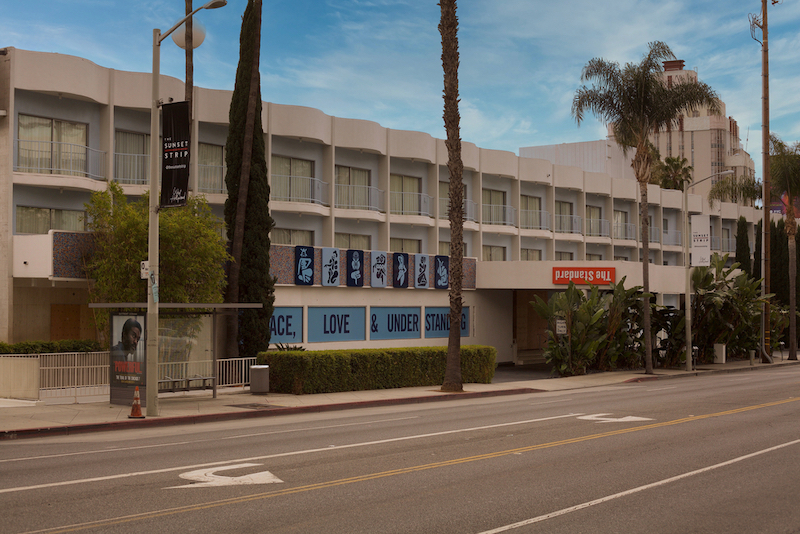
Shawn Hausman
The hotel was a good space in the sense that everything was horizontal. You traveled horizontally from one room to another room and one environment to another. We created a social space [in the lobby]. I think the whole time I was trying to create an environment or a background for people to connect and interact. It’s really about the people, not the place.
David Lemmond
It was easy to envision this kind of midcentury-modern building transforming into something cool. But, even if [Balazs] said it was going to be next-level cool, I don’t think I fully understood who André was or what was actually in store until much closer to opening.
Sebastien Meler
Nobody had really done a hotel like that before. There was the Mondrian, but… [voice trails off]. It was the first time bridging a gap between a nightclub and a hotel.
David Lemmond
I think André had a very clear idea in his head what he wanted this hotel to be.
The early days, ‘a bunch of kids,’ and an Oscars party
As the design team made progress, Balazs began hiring his first full-time employees, including David Lemmond as assistant general manager. The hotel soft-opened in late 1998, months before Balazs held an Oscar party in March 1999 while the hotel was still under construction.
David Lemmond
I was the second full-time employee and I shared an office on the third floor with Melissa Volpert, who was the first full-time employee. I was responsible for operations of the hotel, so housekeeping, engineering, front office, reservations. All the things that André was not super involved in. André was creative, visionary. The day-to-day operations — not really his type of thing.
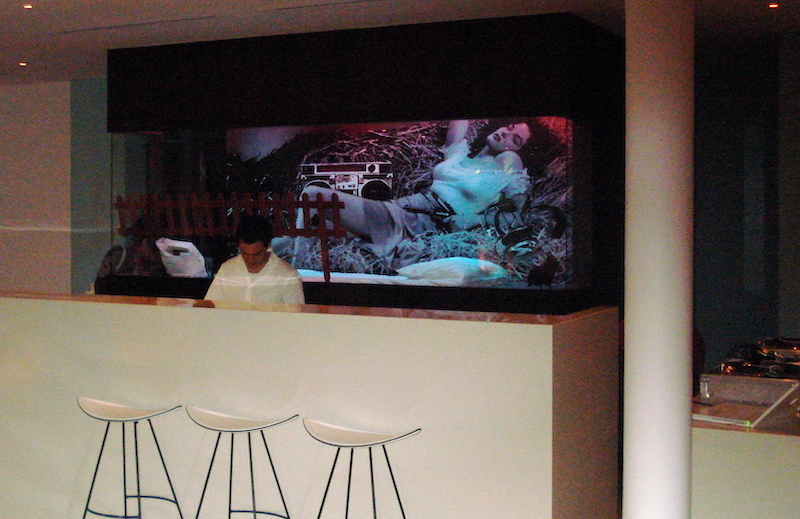
Jasmin Estrella, front desk (1998-2000)
I was one of the first five employees. David Lemmond hired me for the front desk.
Alan Dunn, food and beverage manager (1999-2000)
I was working at the Chateau Marmont doing events. Then I got a job as food and beverage manager at The Standard.
“In the beginning with the hotel, it was something new, so you really had to be in the know to stay there or visit there.”
— Sebastien Meler
Sebastien Meler
In the beginning with the hotel, it was something new, so you really had to be in the know to stay there or visit there. It was just a really cool vibe. We had a lot of people in the [movie] business, when they came in from New York.
Jasmin Estrella
We had a really interesting roster of guests in the early days. The Ronson twins [Charlotte and Samantha] were some of the first ones. We had a lot from Condé Nast, when they were in from New York. Tina Weymouth and her husband, Chris, of Talking Heads were in town producing something, and they stayed at the hotel in the early days. I remember a lot of New York personalities.
Alan Dunn
There were only two of us [in food and beverage] at the time, one taking on all the night shifts and one taking on all the days. The first 40 days I worked there I worked non-stop. It was a very loose situation. Just a bunch of kids.
Jasmin Estrella
There was a mix of really creative people right in the beginning, like the first six months. I remember the director Ben Younger was staying there and he had just finished his first movie, “Boiler Room.” He received a gift from one of the actors who thanked him for putting him in the movie, and Ben Affleck had a motorcycle delivered to Ben Younger at the hotel. As a gift. Ben Younger was there around the same time as Wes Bentley, who was the young kid in “American Beauty.” At the same time, Val Kilmer’s assistant was at The Standard while Val Kilmer stayed at the Chateau.
David Lemmond
We had soft-opened and we were working out of a temporary lobby for a while. We weren’t even in the main lobby. Vanity Fair came out to do a shoot at the hotel. We were running around the building, trying to make it look as finished as possible. It wasn’t.
Alan Dunn
It was fun. We hadn’t done the official opening yet, and we definitely hadn’t opened the restaurant [the 24-hour diner] yet, so it was kind of a free-for-all for a bit.
Jasmin Estrella
I ran into [record producer] Daniel Lanois at Starbucks, which was just down the street, while he was staying at the hotel. We talked a little. Then every morning that I worked opening at 7 a.m. while he was there, I’d see him come out of the elevator on his way to Starbucks and he would come back with my coffee. We had all these down-to-earth conversations with these crazy-talented, successful artists from every sector, and then to have one of them bring you coffee every morning? It was amazing.
David Lemmond
I knew I wasn’t in for a slow ride when, on the night of the Academy Awards, André hosted a party at the hotel. We had the temporary lobby and hadn’t even opened the main lobby yet. I was passing between the temp lobby to the main lobby on the other side of the building and I was like “Oh…that’s Uma Thurman. Just walking down the hall and she’s wearing the gown she wore to the [Academy] awards earlier.”
Jasmin Estrella
I worked the night of the Oscar party. That was like an explosion. There were people all over the place. I just remember ending up on the dance floor in the room off of the side of the lobby. I think Mark Ronson was there. Seeing that being pulled off… You’d be surprised what can come together in 48 hours. Looking back, it felt very much like a movie set, with props and everything.
David Lemmond
Over the course of the next few weeks [after the Oscar party] the people coming in were so different. We had a lot of people who were envisioning this über-cool, super-slick property and they would get there and it was just kind of an old roadside hotel that had a lot of lipstick on it. And it WAS cool. It WAS fun. But it was not polished, by any stretch.
Jasmin Estrella
When the temporary lobby was still open A Tribe Called Quest stayed there. Robert Downey Jr. was living there for a little while. He was very cool.
David Lemmond
A few weeks after the Oscars party, I was checking-out some women at the front desk who were older, very stylish. I remember thinking, “They are clearly at a hotel not befitting of who they are.” They were commenting about the noise and they said, “You know, when we tour Europe, hotels usually comp us when there’s this much noise.” Afterward I was like, who was that? It was the women from ABBA. But, at that moment, we were just trying to keep our heads above water and not necessarily curating the experience for each guest. The volume [of people] was just so… It was crazy.”
The hotel officially opens with a ‘who’s-who Hollywood moment’
The hotel held its grand opening in spring of 1999, and shortly after, the Vanity Fair article hit the stands in early summer.
David Lemmond
Right before the opening, André pulled me aside and was like, “Hey, David, are you really ready for this?” I was just like “Ready for what, André?” And he’s just like, “For what’s about to happen.” I said, “What do you mean by that?” He said, “When the Vanity Fair article comes out, everything’s going to transform. It’s really going to change.” But I wasn’t ready. I was in no uncertain terms ready for what transpired. The article came out and the whole vibe at the hotel changed. With the article, the full opening and moving into the main lobby, we just got everything up and running.
“I came to André, who was out by the pool, and was like, “Listen, Matt Dillon, Vince Vaughn and Heather Graham are all trying to get in and security is not letting them.” André’s just cool as a cucumber. Very suave. He was just like, “Tell Matt and Vince I’m sorry but if the fire department says we can’t let them in, we can’t let them in. And who is Heather?”
— Alan Dunn
Alan Dunn
I worked the grand opening. Everybody wanted to get in. We had this VIP area in what became the nightclub on the east side of the building and it was packed like sardines.
David Lemmond
[The opening] was crazy busy.
Alan Dunn
I remember Matt Dillon trying to get through [at the grand opening] and arguing with the security guys that he was a guest of André’s. Security was like, “The fire marshall is going to shut this down; we cannot let anyone else in.” Vince Vaughn was the same way. Heather Graham was trying to get in too. I came to André, who was out by the pool, and was like, “Listen, Matt Dillon, Vince Vaughn and Heather Graham are all trying to get in and security is not letting them.” André’s just cool as a cucumber. Very suave. He was just like, “Tell Matt and Vince I’m sorry but if the fire department says we can’t let them in, we can’t let them in. And who is Heather?”
Chris Black, co-host of the “How Long Gone” podcast
Celebrities and bands would stay there. But there was still a scene even though there were also tourists. That somehow that never took away from the vibe.
Sebastien Meler
Smashing Pumpkins were hanging out in the lobby one night. I remember Paris Hilton used to hang out there before anyone knew who she was, and she was dancing on the sofas and the shag. In the restaurant, I remember the Charlie’s Angels had dinner together at midnight one night. It was Drew Barrymore, Cameron Diaz and Lucy Liu. That actor Jared Leto was a regular who would stay there early on.
David Lemmond
I remember Andre came up to me and was like, “David, there’s a DJ coming in tonight and I need you to take care of him. His family are really good friends of mine, and please just take care of him.” I’m like, “Of course, André. I’ll make sure he’s well taken care of.” It was [DJ] Mark Ronson. He just walked in and spun at the lobby desk for a couple of hours one night. As Mark Ronson might do in your hotel lobby.
Alan Dunn
It was definitely a who’s-who Hollywood moment. It went like that for a bit.
David Lemmond
[The hotel] wasn’t super high-end. It wasn’t unattainable. On the Sunset Strip, if you’re a common person off the street, it’s often about “Can I go? Can I get in? Can I participate?” And the answer at The Standard was, “Yes, you could.” We still had someone at the door managing the flow. But, that really had to do with the constant demand for the space more than anything else. It wasn’t a velvet rope. It wasn’t an exclusive scenario.
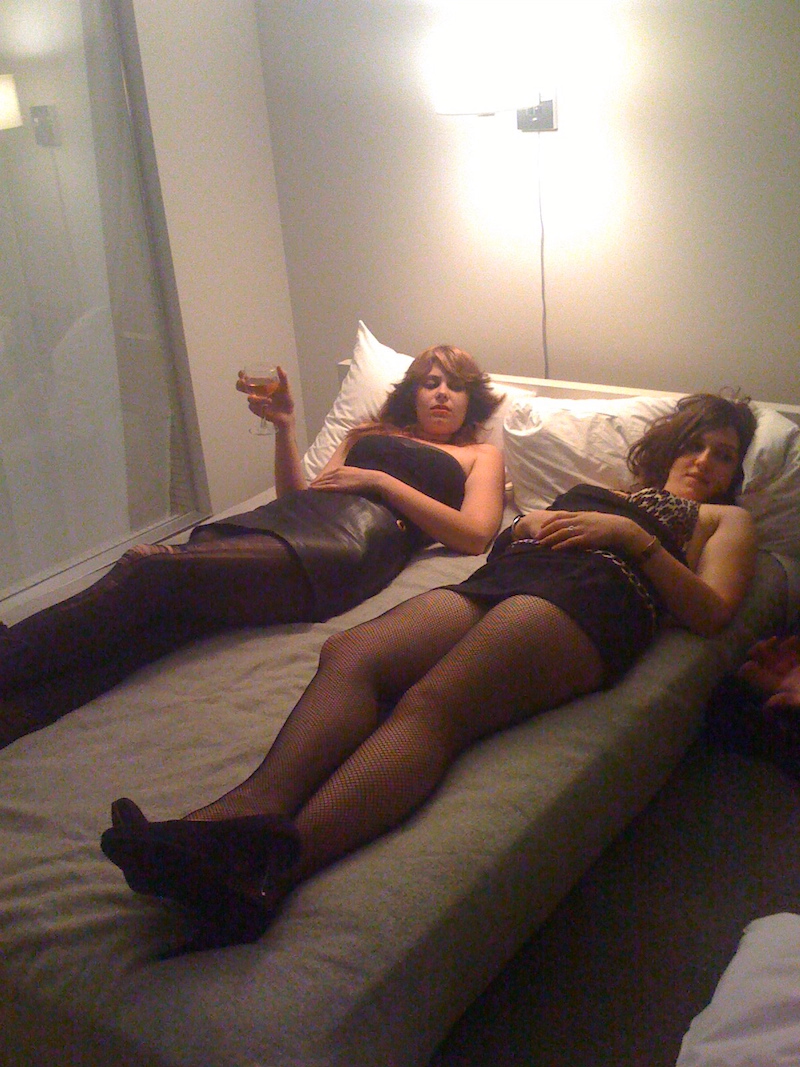
Shawn Hausman
The hotel was noisy. There was no insulation between the original walls. We didn’t tear down the sheet rock or anything. I think that was part of what kind of the energy of The Standards.
David Lemmond
[Once we opened], the challenges were trying to run a hotel and manage the expectations of people who were worldly and well-traveled and really had high expectations, but the hotel didn’t necessarily always live up to the expectations.
Sebastian Meler
The lobby was like a party.
“That hotel was an advent in many ways for Los Angeles as a city, like the way the 101 Club was in England or CBGB in New York.”
— Dan Mancini
David Lemmond
At night, you’d watch people lounging around in that lobby space on the shag rug, that by day you were like, “Yeah, I prefer to never touch that rug with my hands,” but at night everyone is laying on it, having the best time and never thinking about all the things that have gone on before. The lobby was wild.
Dan Mancini, DJ at The Standard, Hollywood and, later, nightlife director
That hotel was an advent in many ways for Los Angeles as a city, like the way the 101 Club was in England or CBGB in New York. It just felt like a movement was coming out of that hotel. And it always felt like that. It was always fresh.
A hat tip to NYC nightclub Area
After the hotel opened in 1999, Meler moved from the design team to the hotel staff. He booked DJs for the lobby and models to occupy/perform in the vitrine — “the box” — behind the front desk.
Sebastian Meler
The box behind the front desk was Shawn Hausman’s idea.
Shawn Hausman
The box that we did behind the front desk, that was kind of an homage to Area. The idea was that this was like the windows we did at Area where you hired somebody and it was a very specific type of performance, that they were just meant to be sleeping. It was a hotel and people are sleeping there, so it was very much like a conceptual piece.
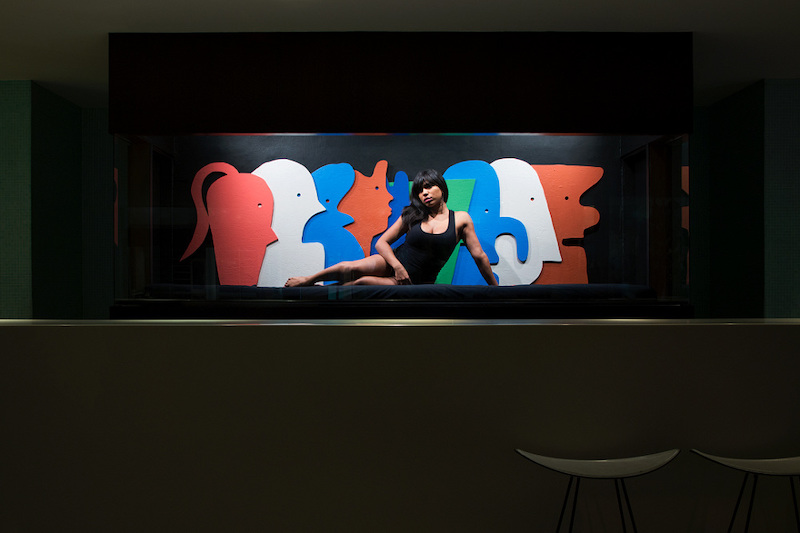
Sebastian Meler
I hired the box models but I didn’t want some cheesy show. I stayed away from girls who looked too L.A. or who were Playboy looking. It was meant to be more interesting people as opposed to someone who looked like a stripper.
Dan Mancini
I was a lobby DJ. I’d be playing in front of these underwear models in the glass box in the lobby as people were checking in. It was insane coming from a small town in New Zealand to this situation in Los Angeles which was a whole different level of hospitality. I ended up being the box’s model booker for many years [after Meler], which was a surreal job too.
Sebastian Meler
Mia Moretti, who was an actress and was friends with Katy Perry, she DJ’d sometimes. She was very fashionable; a kind of “it girl.” She did the box for me every once in a while.
Dan Mancini
We were not going for, like, a “Baywatch” buxom blonde; we were going for more artist types. We wanted people who were interesting doing interesting things, but we didn’t want them to interact with guests. I remember one woman learned to play guitar in the box. There were actors learning lines in there.
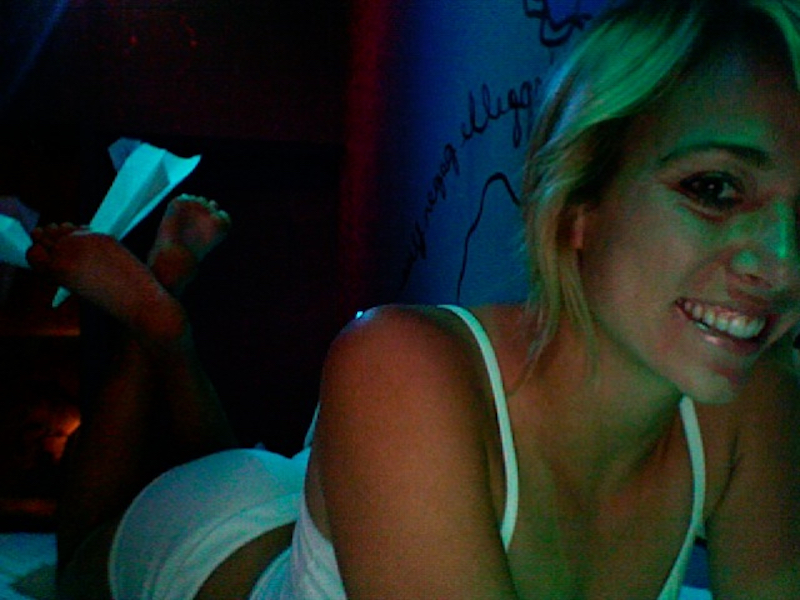
Lilibet Snellings Kyte, author, “A Box Girl” (2005-2010)
I had a great experience as a box girl. I was interning at Flaunt magazine, and one of the other interns was a box girl. She said they were looking for a new blonde, and asked if I was interested. There were no rules inside other than “no eye contact” with anyone outside of the box. I’d read, write on my laptop, send emails, make phone calls. By about midnight every night, I’d fall asleep for the last two hours, until 2 a.m. when the concierge would knock on the glass to wake me up and let me out.
Sebastian Meler
I don’t remember how we got the original models but over time it became, like, girls in the lobby would go up to the desk and ask them, “How do I get that job?”
Lilibet Snellings Kyte
Being a writer, I was always seeking out strange experiences to write about, so I took the job. Like when Gloria Steinem became a Playboy bunny just so she could write about it, I too wanted to infiltrate this world. I mean, what a fascinating human experiment. To get to be the animal at the zoo. But the animal at the zoo with a laptop and human-sized brain.
“We were told to behave in the box as if we were sitting in our living room. Which was ironic because at the time I did not have a living room.”
— Lilibet Snellings Kyte
Sebastian Meler
I hired guys in there too, just not as many. I had a performance artist from New York who would dress up the box and do really weird stuff. I remember he and his girlfriend dressed up in military gear and played with toy soldiers in the box. He would do all kinds of weird stuff.
Lilibet Snellings Kyte
We were told to behave in the box as if we were sitting in our living room. Which was ironic because at the time I did not have a living room. And when I sat in my one-room studio apartment in Venice I most certainly didn’t do so wearing tiny white boy shorts and a tiny white tank top. But for the most part, I could do whatever I wanted.
Sebastian Meler
Mini-Me [actor Verne Troyer from the Austin Powers films] would do the box. He would hang out at the Purple Bar and one of the waitresses would help out in the box. Vern would go in the box with the waitress.
Lilibet Snellings Kyte
The most interesting part was that people assumed I couldn’t hear them while I was inside. But I could hear everything. It was typically pretty benign: people asking if it’s hard to breathe in there (no), everyone always asking if I was allowed to go to the bathroom (yes). One time, however, it was super creepy. Some old foreign dude eyed me up and down and asked the concierge, “How much for an hour?” Like it was the Red Light District in Amsterdam.
Sebastian Meler
I was also looking for unique DJs. Not the cheesy nightclub DJ, but ones that had interesting tastes in music and they were almost characters themselves, with the way they looked and dressed and their whole vibe. The lobby was kind of a show because they were DJing at the front desk. You had these front desk agents in nontraditional uniforms and a DJ right there [to the right of the check-in desk] and then the girl in her underwear in the box [behind the front desk].
Lilibet Snellings Kyte
Needless to say, I’m thrilled I accepted the gig because I thought I was just going to write a magazine article about it, but it ended up becoming an entire book — about being a box girl and my larger life in Los Angeles.
The pool’s ‘colosseum’ party
Besides the lobby, the hotel’s pool was a natural gathering and party spot. In that area, Hausman added simple features that played off the pool’s colors.
Shawn Hausman
If you remember, before it was a retirement hotel, it was the Thunderbird Inn. So it was a very classic kind of hotel-motel — the layout of the rooms, the pool, the pool deck and stuff. So we used the existing pool, but that whole outdoor area, André had originally had Martha Schwartz, a landscape architect, design something. A lot of the approach for stuff when I started was constrained by budget. So, the pool design was a budget thing. How do we do something simple? I just came up with this move of doing the all-blue AstroTurf on the existing deck. Then you have all the white furniture, and the pool was there.

Alan Dunn
My primary job was overseeing the pool bar. There were a lot of good-looking young people working there. Everyone indulged.
“The balconies by the pool, it was like you were in a Roman colosseum and could watch the partying, but also celebrate and endorse the partying that happened below.”
— Dan Mancini
Shawn Hausman
With all the patios facing the pool, people were performing in a sense — just as much from their decks for the people on the pool, as much as people at the pool performing for the audience of the rooms. It created a whole energy.
Dan Mancini
The balconies by the pool, it was like you were in a Roman colosseum and could watch the partying, but also celebrate and endorse the partying that happened below. That colosseum set up with people throwing drinks down to everyone at the pool and all kinds of silliness? It wouldn’t fly nowadays.
Chris Black
The pool scene and the ping-pong tables were great. I remember one time the pool was packed, and I was alone but had a table for four because I was staying at the hotel so they let me sit there. These three dudes were like, “Can we join you?” I was like, “Yeah, sure.” It ended up being this very strange but fun night with Sticky Fingaz from the rap group Onyx and his boys. We had a great conversation, he paid for my meal, and we went on with our lives.
Shawn Hausman
We created that social area outside and made a very bold graphic from the rooms, because part of that hotel was the social part. I think that drove some people a little crazy, if they didn’t know [how noisy it was] and wanted a quiet room.
Chris Black
Nothing looked like it at the time. The blue carpet, the bathrooms were orange. In the rooms, the dials for the air and heat that said “blow” and “blow harder.” It was all so cheeky. It was the first place I ever saw a condom in the mini-bar. Which is so commonplace now.
Dan Mancini
People went absolutely crazy when the co-ed bathrooms opened. That was unheard of at the time. That was new. Now it’s just par for the course.
Chris Black
That’s the first place most people sat on Ligne Roset Togo sofa couches, which got totally overdone in 2023.
The hotel’s Purple Lounge, a 100-person club that was located off of the lobby, through the 24-hour diner, was a celebrity hot spot in the early 2000s. Also off the lobby was Rudy’s Barbershop, an irreverent hair styling chain founded in Seattle in 1993. This was the first Rudy’s outpost outside of the Pacific Northwest, before a permanent move to Los Feliz. Two of the founders of Rudy’s would found the Ace Hotel in 1999, around the same time The Standard opened.
Dan Mancini
When I was DJing in the Purple Lounge it was at its height of popularity. You’d go in there and you’d have Lindsay Lohan, Paris Hilton, Britney Spears, Jerry Buss — who was the owner of the Lakers and he’d be there WITH all the Lakers — and Hugh Hefner with all of his girlfriends. And they’d all be behind the DJ booth being silly. It was this absolute weird, Sunset Strip wild ride. It was very much a VIP, in-the-know situation. Especially Monday nights at the Purple Lounge and then Tuesday nights at a club called Joseph’s in L.A. Those were the hot spots at that time.
Ned Brower, Rudy’s Barbershop (2003)
My version of The Standard hotel was from the vantage of Rudy’s Barbershop, which was a venture from Seattle that served as a hair salon and impromptu gift shop. The wait for a haircut was anywhere from five minutes to five days depending on how stoned the barber was. I ran the register and played the loud ’90s Britpop soundtrack while my best friend served as the aforementioned stoned barber.
Sarah Morris Brower, Rudy’s Barbershop and the 24-hour diner
I started working at Rudy’s Barbershop, but I begged Alan Dunn to hire me at the diner even though I didn’t have much experience. Eventually he did, but it turned out to be kind of a step down. We had to wear these skimpy diner outfits, and since I was the newest hire, I started with the graveyard shifts, which could be brutal. It’d start out fine, but come 2 a.m. when all the bars closed we’d just get flooded with drunk, coked-up assholes. I only lasted about three weeks.
Chris Black
I’ve been sober for a while now so I can look back on this fondly, but I did a lot of cocaine in that hotel. One time, I had partied late the night before. I had to get up and go do something, and I came back to the room and it had been cleaned and there was just a piece of paper placed over a pile of coke that was on the table.
Alan Dunn
This was sort of the dot-com era, right before the bubble burst. I remember there’d be guys at the door who were like, “Listen, I’ll give you $300 to let me and my dudes in,” which was not the thing [to do], letting a bunch of guys in. But the door guys would take the money, but it’d be 25% full of people. It was a moment but it didn’t have legs.
Sebastien Meler
But then, we kind of slowly started seeing the cool aspect go away. I remember I stopped seeing big actors at literally the same time I started seeing soap actors and then started seeing tourists from the Midwest. So it went from hip and edgy and really in the know, to being full of cheesy celebrities and soap stars. Very suddenly it wasn’t as cool as it used to be.
And just like that…
While the coolness of the Hollywood location dimmed, by 2012, André Balazs Properties owned and operated five Standard hotels, in Downtown Los Angeles, Miami Beach, New York (two) and the original in West Hollywood. Balazs sold an 80% stake in the company in 2013.
Shawn Hausman
Ideas evolve. The Standard ended up maturing in ways over time. But you realize that what came to be as a brand, I guess, was set [at The Standard, Hollywood]. The staffing, the energy, the humor — the consistency of those things — and the energy of that social space and the quantity of social spaces mixed with the quantity of rooms. These [hotels] became destinations as a social place. That carried through to all The Standards.
Chris Black
The closing was kind of unceremonious; it sorta just went away. It was a more important place than it got credit for.
Shawn Hausman
I still hold on to the fact that the real Standard is that original Standard, you know? I think at a certain point the brand shifted to the High Line as the definition of The Standard. But to me, [the original Standard] was always in the spirit of everything.
Jasmin Estrella
I think I’m most proud of just having been a part of that team that opened the hotel. It was such a fun experience.
Sarah Morris Brower
Working there did come with some cachet. I went on to work at some other cool hot spots after that — Mumba and Chateau Marmont — and having The Standard on your résumé was kind of a testament to you being able to handle your shit.
Lilibet Snellings Kyte
I have nothing but love for The Standard.
Shawn Hausman
I’m proud of the intelligent approach. Of working with what was there to create something new. Without sounding arrogant or something, we really created this whole movement of hotels with that hotel — these kind of hip, budget, whatever words you want to use. Now it’s so oversaturated. But I’m really proud of being an involved part of that.
Sebastian Meler
It was a cool, hip spot like no other, that had never existed before. I was proud to be part of something that was revolutionary and the first of its kind. Now everyone is trying to do something similar.
Lilibet Snellings Kyte
The scene, in general, back then was so special because it was very raw and unfiltered. There was no Instagram; there weren’t even iPhones. You had to actually go out to find out where your friends were, or where that guy you had a crush on was. There was something very romantic about it. We were all very present. No one was putting on an outfit or showing up to a party or an event to post a picture about it. We were just living it.
Dan Mancini
Whatever it becomes — and of course it will be something new — it will never be what it was. It can’t in today’s culture. I’m not talking about the progress in culture, which is absolutely necessary. But that snapshot in time, it can never be repeated.


